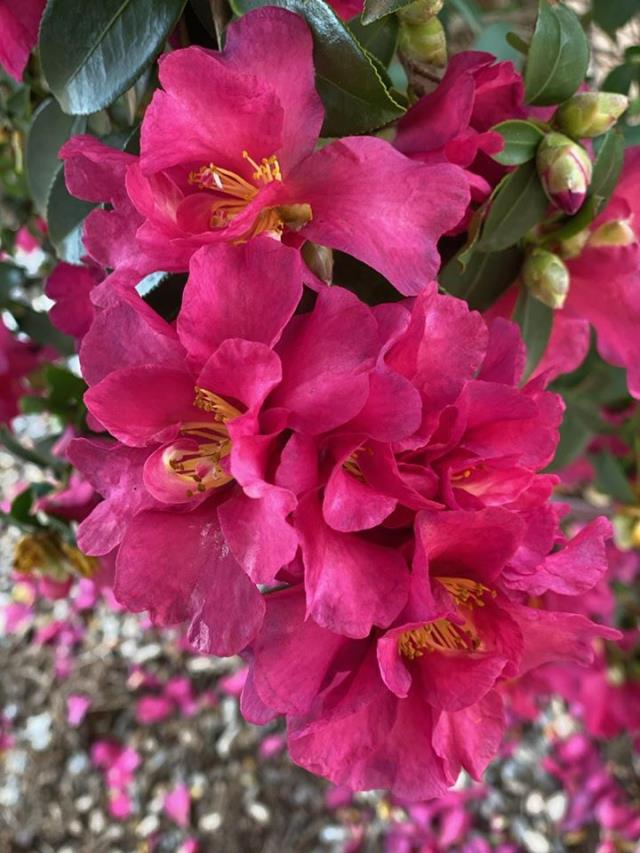By Beatrice Hawkins
I’ve noticed some beautiful camellias in gardens around town so thought I’d find out a little more about these great shrubs.
They are a very hardy plant once established and supply beauty and colour at a time when there is a definite lack through winter.
If you plan and choose carefully it is possible to have them flowering from early autumn right through to late winter and early spring.
Camellia Japonica, Sasanqua and Reticulata are the most common varieties but there are literally thousands (20,000+!!) of cultivars and hybrids.
After water, tea is the most consumed drink worldwide. The tea plant is actually a camellia variety, camellia sinensis, and all the types of tea are derived from this cultivar, but you won’t find many of these in home gardens.
They’ve been grown here in Australia for over 200 year having been brought out in the very early days of European settlement.
The japonica is probably the most recognisable but the sasanqua is really lovely and very popular. It has the habit of dropping its petals almost daily and providing a lovely carpet of colour around the shrub – this is not always popular with “tidy” gardeners! I love it but have a brother that it would drive to distraction!! He doesn’t like jacarandas, frangipanni or deciduous trees either!! It’s a fun point we choose to differ on!
As to soil requirements, they like a well drained slightly acidic soil with a pH range around 6 to 6.5. As with most things regular additions of compost helps to maintain this level and keep the soil friable.
One of the common problems the world over with camellias is “bud balling”, when the buds form but do not progress to open flowers. One of the simple remedies for this is to dissolve 2 teaspoons of Epsom salts in 10 litres of water and water all around the plant with that. Alternatively, or as in my thoughts, as well as, give the plant a good feed of Camellia/Azalea fertiliser or finally as a last resort, relocate the plant to another spot in the garden.
I thought I would try and find some fun facts and ideas about gardening to lighten the mood and give you all something different to think about.
1: Lachanophobia is the fear of vegetables.. fructophobia is the fear of fruit… fear of apples: Malusdomesticaphobia! There appears to be phobia for all reasons!!
2: Lemons are technically a berry. Specifically they are a hesperidium a berry with a leathery rind.
3: Strawberries are not berries. But avocados, watermelon, bananas and pumpkin are! Think I’d rather eat 1 strawberry than 1 pumpkin!
4: Grapes explode when you microwave them… good experiment for the children… just as long as mum or dad are ok with cleaning the microwave!
5: Someone who studies fruit is called a “pomologist”.
6: The bumps on raspberries are called “drupelets”.
7: Australia’s “Gympie Gympie” tree is the most dangerous tree in the world with their leaves giving a very severe sting that is so painful it has resulted in suicide.
8: A pineapple is actually a berry.
9: There are over 10,000 varieties of tomatoes and 130 million tonnes are produced each year.
10: Tomatoes were once considered poisonous but are now the world’s most popular fruit followed by bananas.
11: Bananas are not a fruit however, but a herb!
12: The first recorded green house built in North America was in Boston in 1737 by Andrew Fanueil.
13: 88 million tonnes of tomatoes are for the fresh market and 42million for processing.
14: The world’s largest producers are China, EU, Turkey, USA and India.
15: Nearly 1,000 jasmine flowers and a bunch of roses go into each bottle of Chanel No 5.
16: The first decorative gardens appeared in Egypt around 1500 BC.
17: Herbs are from the leaves of plants but spices are from the root, bark, berries or bulbs.
18: According to Sir Francis Bacon gardens are the “purest of human pleasures”!
19: Garlands of Chrysanthemums were said to ward of demons, and drinking the dew from the flowers was supposed to prolong life.
And finally
20: The first Sunday in May each year is celebrated as World Naked Gardening Day!… Darn, I’ve missed it!!
*This is an old article that has been digitised so our readers have access to our full catalogue.







